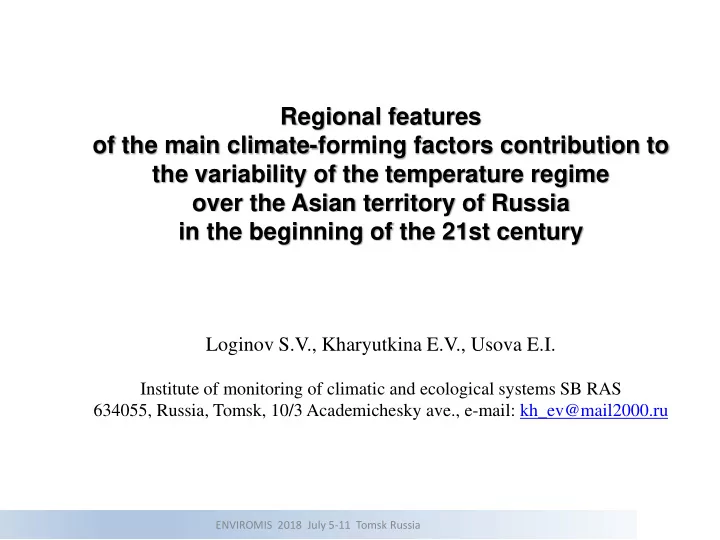

Regional features of the main climate-forming factors contribution to the variability of the temperature regime over the Asian territory of Russia in the beginning of the 21st century Loginov S.V., Kharyutkina E.V., Usova E.I. Institute of monitoring of climatic and ecological systems SB RAS 634055, Russia, Tomsk, 10/3 Academichesky ave., e-mail: kh_ev@mail2000.ru ENVIROMIS 2018 July 5-11 Tomsk Russia
GOAL To study the peculiarities of climate variability in northeastern Eurasia at the beginning of the 21st century against the slowdown of global climate warming: TOA radiation balance, surface air temperature and the ocean heat content in the near surface layers 2 ENVIROMIS 2018 July 5-11 Tomsk Russia
Variability of surface temperature 𝝁 - the climate sensitivity parameter, K/(W/m 2 ) ∆𝑈 𝑇 = 𝜇𝐺 Δ F - the radiative forcing, W/m 2 For Region ∆𝑈 𝑇 = = 𝜇 𝑡𝑝𝑚𝑏𝑠 ⋅ 𝐺 𝑡𝑝𝑚𝑏𝑠 + 𝜇 ℎ ⋅ 𝐺 ℎ +𝜇 𝑏𝑒𝑤 ⋅ 𝐺 𝑏𝑒𝑤 3 ENVIROMIS 2018 July 5-11 Tomsk Russia
Net Radiation at TOA (W /m 2 ) 𝐺 𝑡𝑝𝑚𝑏𝑠 ≡ 𝐶 𝑈𝑃𝐵 Q ↓0 – downward shortwave (SW) radiation at TOA, Q ↑ – upward SW radiation from TOA, = 𝑅 ↓0 − 𝑅 ↑∞ − 𝑀 ↑∞ L ↑ – upward longwave radiation (LW) from TOA Net Radiation at Surface (W /m 2 ) 𝜀𝑅 𝑇𝑋 – net shortwave radiation 𝐺 𝑡𝑝𝑚𝑏𝑠 ≡ 𝐶 𝑇𝑣𝑠𝑔 𝜀𝑅 𝑀𝑋 – net long-wave radiation 𝑀𝐹 + 𝑇𝐹 – turbulent heat flux at surface = 𝜀𝑅 𝑇𝑋 + 𝜀𝑅 𝑀𝑋 + 𝑀𝐹 + 𝑇𝐹 Forcing due to atmospheric gas (W/m 2 ) 𝑇𝑋 + 𝐺 𝐷𝑃2 𝑀𝑋 𝐺 CO2 = 𝐺 𝐷𝑃2 𝐺 greenhouse gas ≡ С 𝑔𝑝𝑠𝑑 = 𝐺 CO2 + 𝐺 CH4 𝑀𝑋 𝐺 CH4 = 𝐺 𝐷𝐼4 Database CAMS Climate Forcing Estimates 2003-2012 ( W/m 2 ) Advection of Heat / Cold – wind 𝑊 𝛼𝐼 = 𝑛𝐷 𝑤 𝛼𝑈 – enthalpy gradient 𝐺 𝑏𝑒𝑤 ≡ 𝑅 𝑏𝑒𝑤 = −𝑊 ∗ 𝛼𝐼 The directions of the velocity vector and the heat gradient determined the state: "Inflow" / “Outflow" of heat (cold) air 4 ENVIROMIS 2018 July 5-11 Tomsk Russia
The average annual trend of sea surface temperature (SST tr ) and ocean heat content (Q Tr ) in the near-surface layer (0-300 m) in the Atlantic and Pacific Oceans Q Tr 10 8 , J/m 2 /dec Region SST tr , ° C/dec 1999 - 2014 1999 - 2014 North Atlantic Subpolar Circulation 0,37 3,61 Subtropical Circulation 0,13 -0,68 Gulf Stream 0,29 -2,48 North Pacific Subpolar Circulation 0,17 3,41 Subtropical Circulation 0,01 -0,41 Kuroshio 0,07 -0,85 Significant values are in bold (α= 0.05) CFSR and ERA-Interim reanalysis At the beginning of the 21st century the increase in Q values is mainly occurred at high latitudes in the near-surface layer 5 ENVIROMIS 2018 July 5-11 Tomsk Russia
The depth profile of the ocean heat content Q (10 7 J/m 2 ) in the Arctic Ocean along the latitude of 75 ° N The Barents The Laptev 1979-1998 sea sea 1999-2014 Longitude The Laptev The Barents sea sea Longitude 6
Regions of under study East Siberia Far East West Siberia 7 ENVIROMIS 2018 July 5-11 Tomsk Russia
Changes in climate-forming factors in selected regions 2003-2012 B toa , W /м 2 /dec C forc ,W/m 2 /dec Q adv *10 -10 , W /dec West Siberia East Siberia Far East West Siberia East Siberia Far East West Siberia East Siberia Far East Winter 3,86 7,97 0,04 0,30 0,15 0,11 -270 97 -230 Spring 1,98 -0,77 0,41 0,16 0,23 0,12 150 23 450 Summer -5,06 4,25 7,76 0,11 0,11 0,09 49 9 -180 Autumn 4,12 2,99 1,22 0,16 0,19 0,12 -24 -220 -170 The calculations were performed according to ERA-Interim reanalysis data B toa – the total amount of energy per unit surface per month, Q adv – the average monthly advective total (over all faces) energy inflow in the surface layer (to a level of 700 hPa). 8 ENVIROMIS 2018 July 5-11 Tomsk Russia
Contributions (%) of climate-forming factors to changes in surface temperature for selected regions in 2003-2012 East Siberia West Siberia Far East 100 100 100 80 80 80 60 60 60 40 40 40 20 20 20 0 0 0 Winter Spring Summer Autumn Winter Spring Summer Autumn Winter Spring Summer Autumn Btoa Cforc Adv Btoa Cforc Adv Btoa Cforc Adv East Siberia Far East West Siberia 100 100 100 80 80 80 60 60 60 40 40 40 20 20 20 0 0 0 Winter Spring Summer Autumn Winter Spring Summer Autumn Winter Spring Summer Autumn Btoa Cforc Adv Bsurf Cforc Adv Bsurf Cforc Adv Climate-forming factors The calculations were performed according to Era Interim reanalysis data B toa - Net Radiation at TOA, B surf - Net Radiation at Surface, C forc - radiative forcing of greenhouse gases (carbon dioxide and methane), 9 Adv - advective heat influx ENVIROMIS 2018 July 5-11 Tomsk Russia
Results Regional peculiarities of the contribution of the main climate-forming factors to the temperature regime of the Asian territory of Russia during the period 2003-2012 were revealed. It is established that the radiation forcing of greenhouse gases prevails in spring in West Siberia (up to 40%), in winter and autumn - in East Siberia (up to 50%) and in autumn - in Far East (up to 60%). The contribution of advective heat transfer (up to 33%) exceeds the contribution of radiation forcing of greenhouse gases in winter and summer in West Siberia and in the winter - in the Far East (33%). The results revealed regional and seasonal features in the mechanisms of global warming, which are necessary for monitoring and modeling of regional climate changes. 10 ENVIROMIS 2018 July 5-11 Tomsk Russia
Thank you for attention
Recommend
More recommend